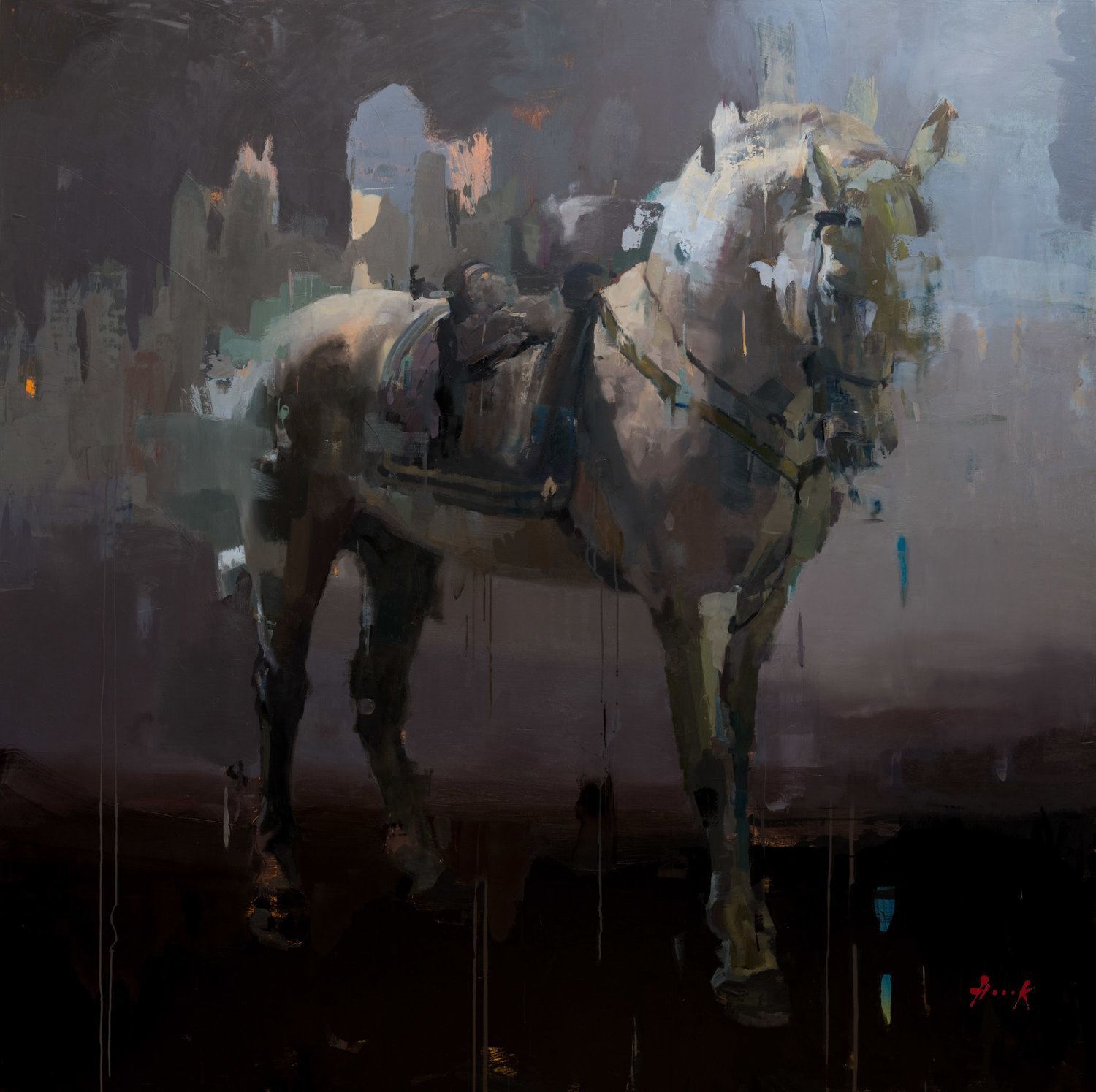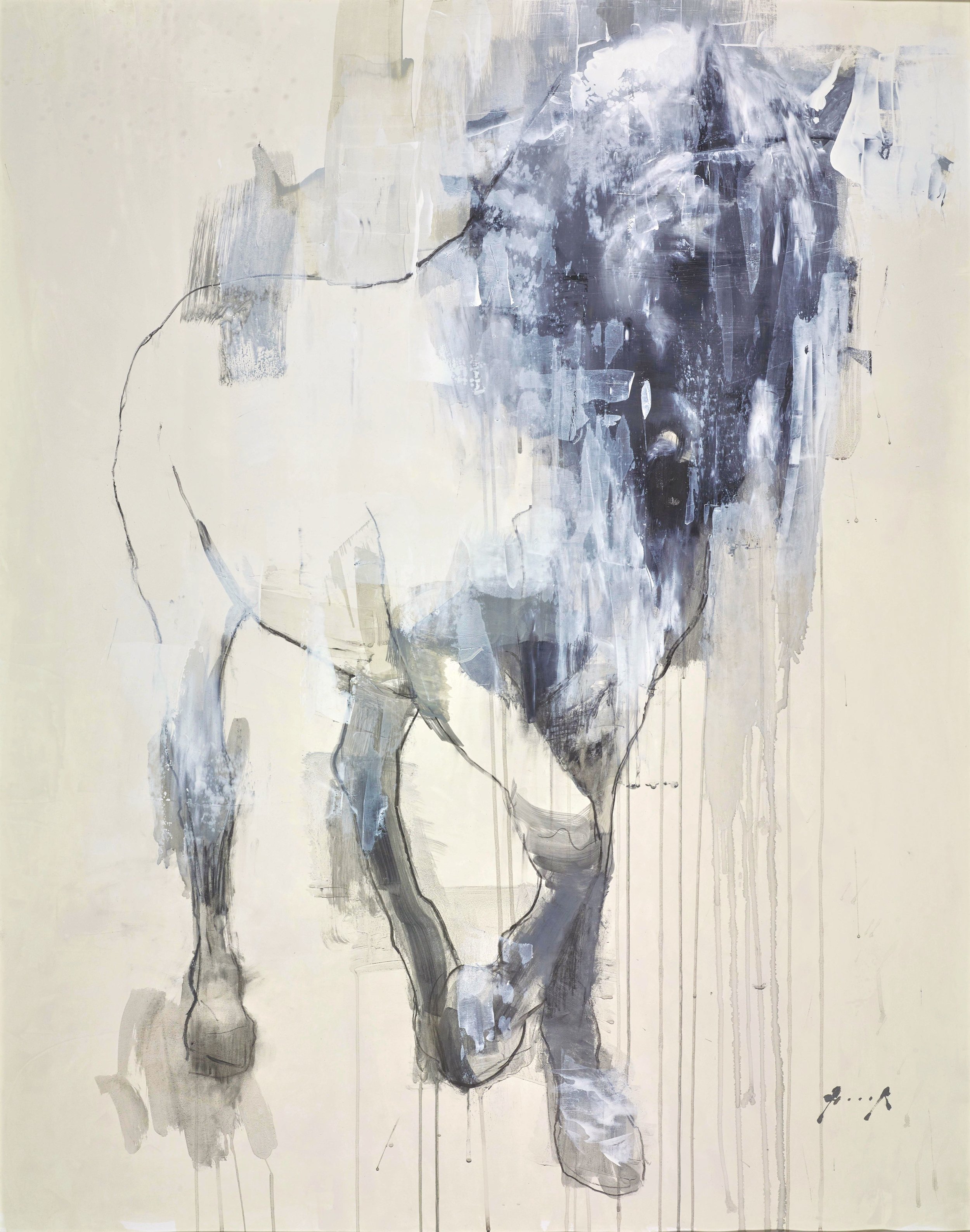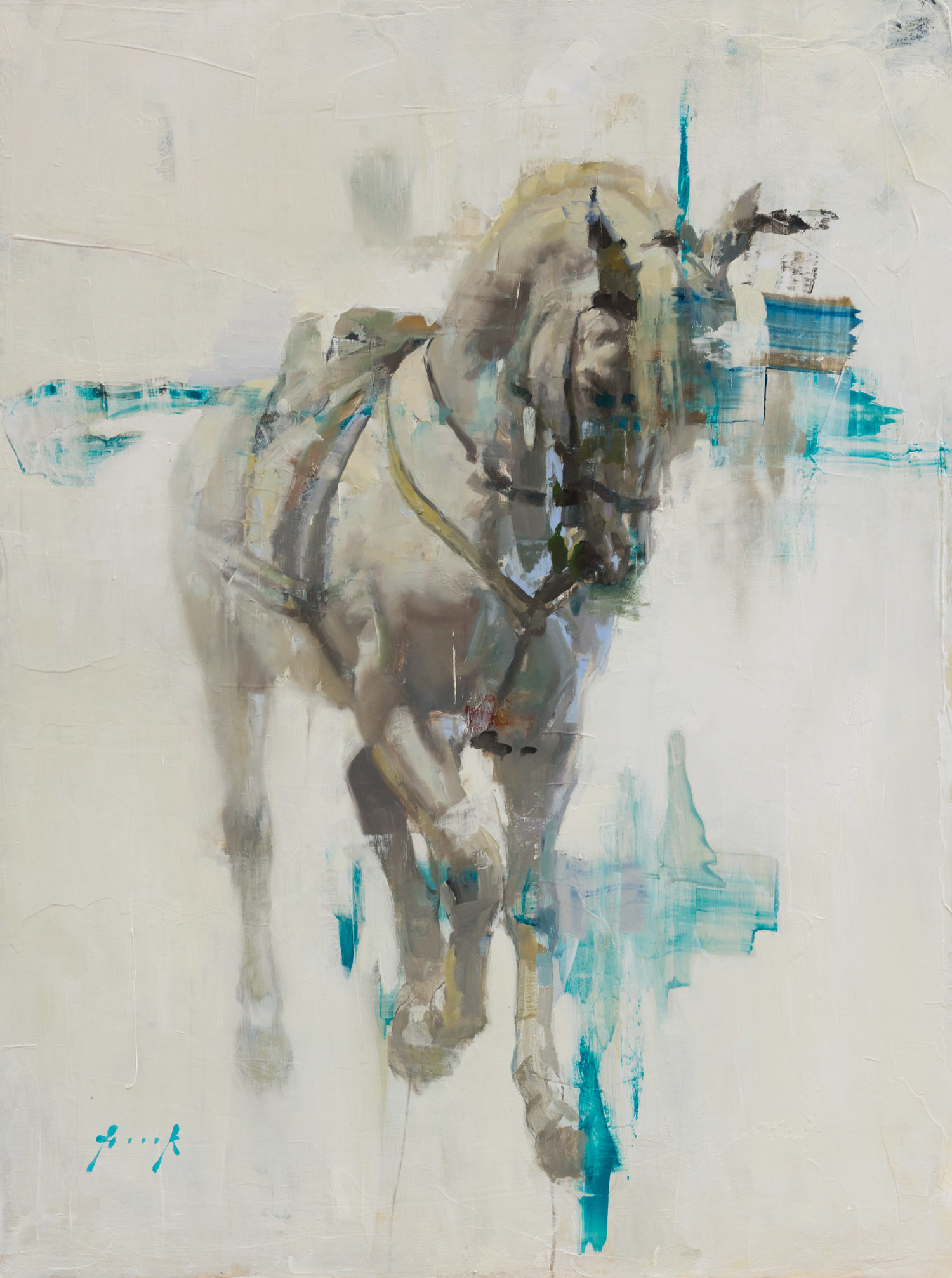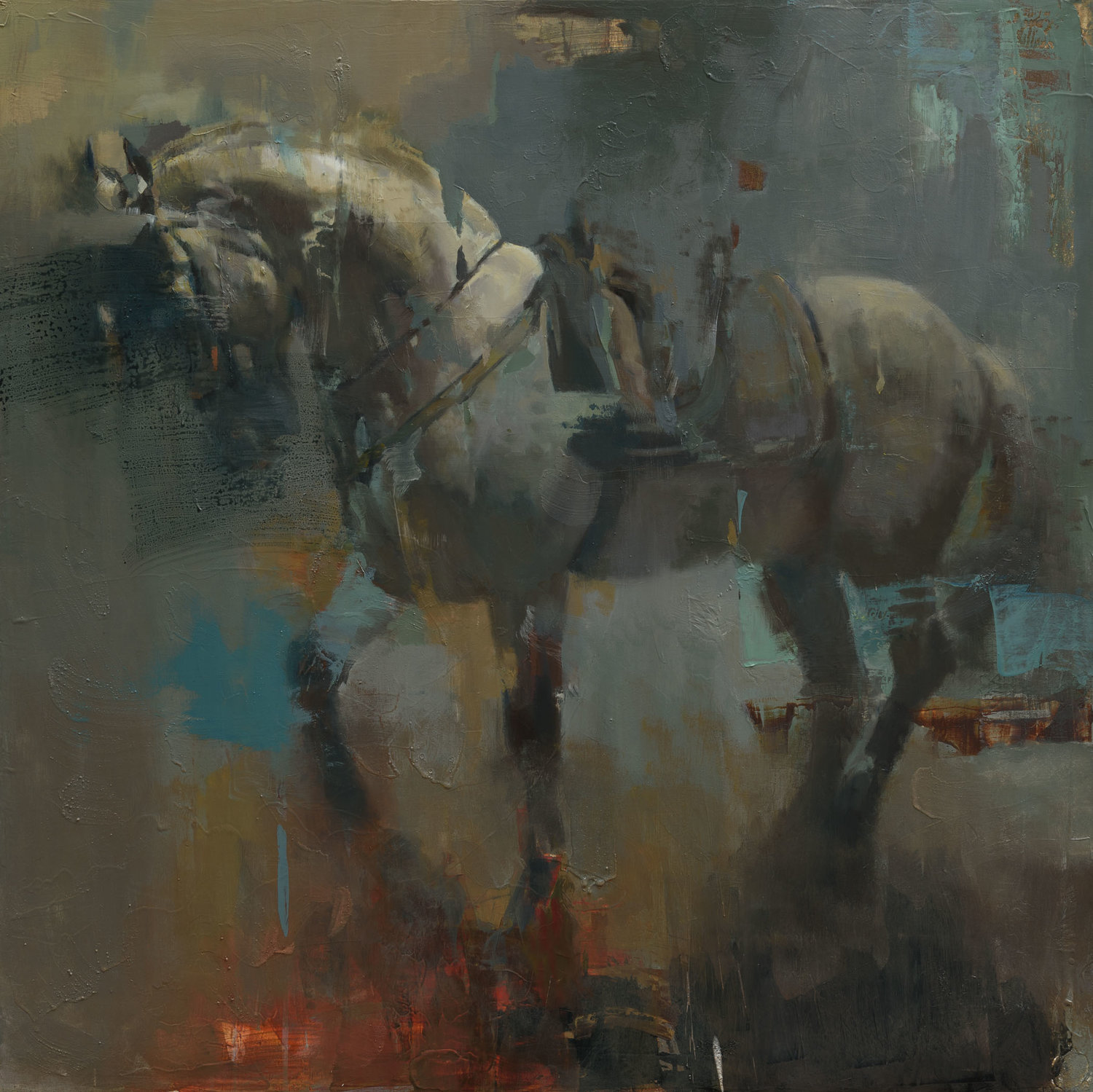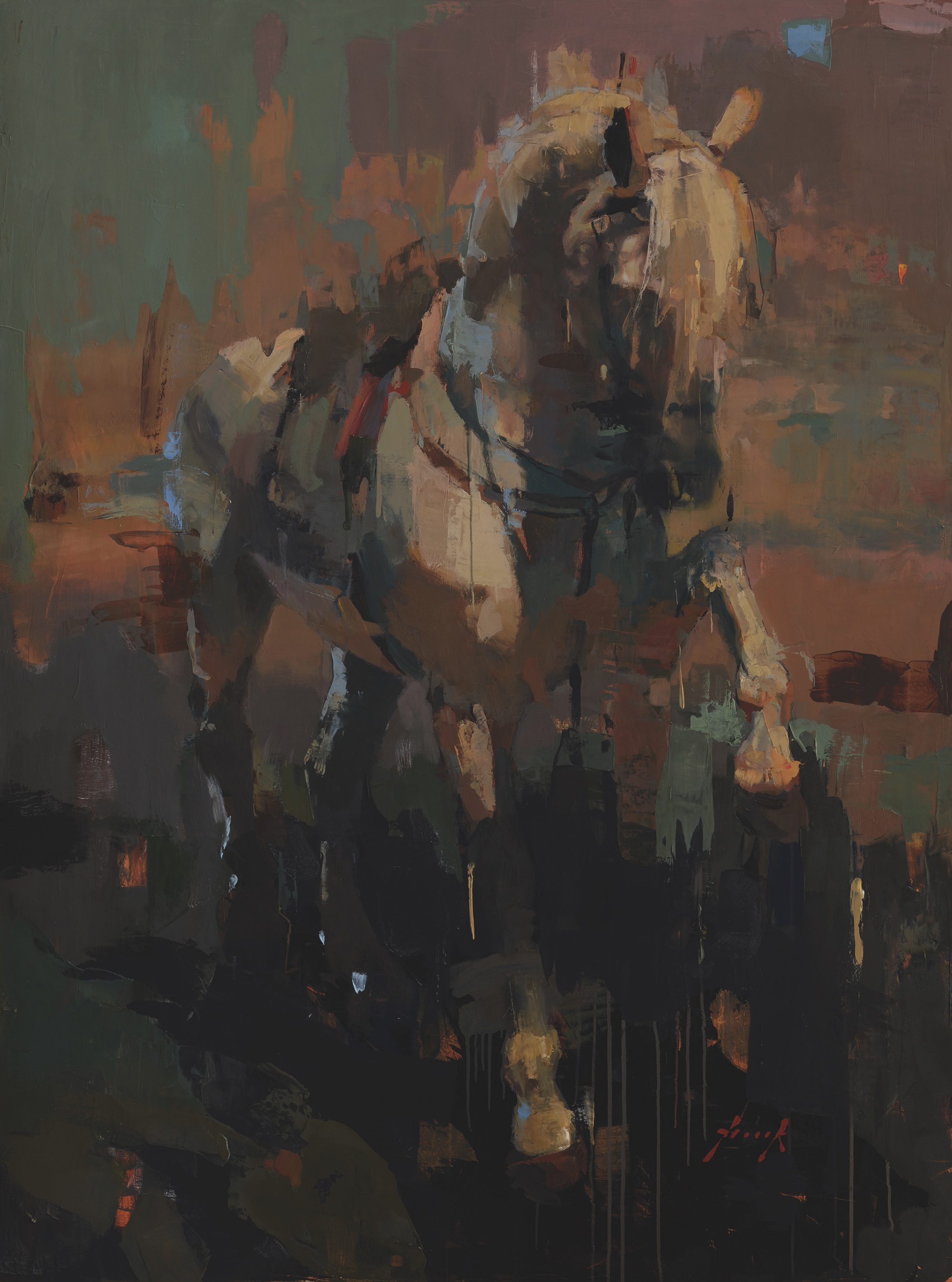Fragmented Memories through Novel Experiences: The Art of Christian Hook
In June of this year, an intimate congregation gathered on board the Cunard liner, Queen Victoria. The Governor of Gibraltar, Chief Minister, Leader of the Opposition, and Ship’s Captain joined members of the press as Mayor Kaiane Aldorino conferred the Freedom of the City on Gibraltarian artist, Christian Hook. It was also an opportunity for the evening’s co-host, Rachel Simkiss of Clarendon Fine Arts, to mark the launch of a new exhibition of the artist’s works. Hook’s ‘The Darwin Series’ interprets Charles Darwin’s On the Origin of Species (1859) through equine anatomy. An excuse, at any rate, for Hook to indulge in what he arguably paints best: horses and the visuals of transition. Demand quickly outnumbered supply. At the occasion he stressed his feelings for his home country:
“I believe that my journey as an artist has only just begun and no doubt it will take me to places far away but I will not forget Gibraltar…I will not forget my roots.”[1]
In the wake of his subsequent exhibition at Clarendon’s gallery in Mayfair (attended by Damien Hirst to drop one of many names), I got commissioned to write an article on Hook, whose artistic bravura and alleged telegenic showmanship (I wouldn’t know as I don’t watch much television) have earned him growing name, fame and game on our Isles and in Gibraltar. Yet, I was told Hook had fled to the East. Not unlike Eugène Dubois, the paleoanthropologist who set out to prove Darwin’s Theory and find the missing link, Hook also travelled to Indonesia looking for a missing link, though one in art.
Meanwhile, having just returned from an academic trip to Florence, I received news from my home in the Netherlands: a metastatic tumour was killing my grand-uncle, and he only had a few days left to live.
No more sun. I arrived in Holland by plane, just in time for my uncle’s cremation on Friday. The landscape of iron earth and skeleton tree is decidedly colourless, and the Dutch markets and cycling lanes of my childhood are veiled by slumbering mists. It will remain wet, and I know the rain will fall straight through the hearts of us mourners. I have not closed my eyes in days.
One final time, around midnight, I try to contact Hook. I realise it is early in the morning on the Indonesian side of the world, and do not expect him to answer. But just as I am about to retire, I get a call back.
“Good morning,” the artist squeaks, laughing, and only half-awake. “Just give me two minutes, and we will chat on camera.”
The air is suddenly filled with expectation. I glance at one of the many paintings that furnishes the room I am sitting in: a posthumous portrait of a young girl by Herman Mees, executed after her premature death at the hands of leukaemia. But that sorry story needs to be told another time.
Presently, an altogether different world pops up on the screen before me. Sporting a white muscle shirt, a couple of wooden bead necklaces, and as broad a smile as my mobile phone will allow, Hook looks masculine but unimposing, and every bit the fun young man he undoubtedly is. He crosses his shadowed verandah and points at the roof, sun-soaked and dotted with dark creatures.
“There they are! Can you see them?”
Do I see the monkeys? Yes, Christian, I see the monkeys on your rooftop. Where on earth are you?
“Oh, I am in Ubud, Bali.”
Ubud is a town located amongst rice paddies, dense forests and steep ravines in the central foothills of the Gianyar regency. It attracts tourists the way a lightbulb attracts moths, and yet its streets have been left deserted ever since a tower of ash rose up from Bali’s Mount Agung a few weeks ago. Hot magma has produced an eerie red glow just above the crater, and cold lava mudflows have poured the slopes. More than 70,000 evacuees have fled their homes and are staying in more than 230 shelters across Bali. When Mount Agung last erupted in 1983, it killed more than 1,100 people. Many of the elderly evacuees this time around survived the last eruption.
“Yes, I am in a monkey sanctuary, so I am like in the middle of the jungle.”
He continues enthusiastically, oblivious to my horror, “They are everywhere! Look at that seat, one of them’s sitting on it!”
Has he been warned of the jeopardy he’s in - the soup he’s dived straight into?
“With everything I have done, with literally every single thing, I have taken great risks to an absolute limit. Without risk no reward, that is the way I see it. Of course, there is the possibility the volcano may erupt whilst I am here. I have seen those dark fumes myself, but I think that risk is really rather small.”
“And yet everyone is alarmed and the tourists have left the island in panic. As a result all the hotels are empty up here, which is great. Actually, it is the best time to be up here. I started off at the bottom, in Seminyak, surfing, and there were tides of tourists there. I feared it would be hard to have proper conversations with the local people up here in Ubud with all those tourists around. For me this emergency is great, because not only do I have all the time in the world to engage with the elders and the craftsmen, but they have all the time for me as well. On another note: I have been to China, I have been to India, but this is the most different thing I’ve seen - it’s an unbelievable place, just like a set of a movie you know. It’s incredible.”
When Hook grew up, Spain had completely closed the border with Gibraltar and had severed all communication links. As a consequence, rocky Gibraltar became an even tighter knit-together community. I ask him whether he thinks Bali - which is made up largely of volcanic rock - is similar in its unity, sense of community and natural isolation.
“Yes, absolutely. Gibraltar felt almost like a tribal community then, almost like this. We were surrounded by the beaches and the sea, where I would fish. Though Gibraltar was a Westernised place which tried to keep up with other European countries, there was no true development, no fundamental change to the way of life of its people. It wasn’t at all cosmopolitan, and almost seemed like a fishing village really, when I was a boy. Now they have changed everything and super-urbanised Gibraltar, and it seems like the charms of that little village have long gone. But, you know, it still is a great place…I was born there and its influences on me are still very strong.”
He appreciates the diversity of his ancestry, with grandparents originating from Malta, Italy, Spain and Ireland. There is his grandmother Marina, whom he painted in a style similar to Freud’s and which is included in his early ‘Pasado’ series. However, featuring even more prominently in Hook’s youth was his grandfather William: a man so fit in old age that “he went to the grave with a six-pack”. This very active man engaged himself in commerce, and Hook notes how times have changed:
“When I was twelve, starting your own business was perfectly normal and fairly straightforward in Gibraltar. There was a lot of dealing and productivity. It took, perhaps, three days in total to complete all the paperwork. Now everything has become so bureaucratic, and everything needs to be completely transparent. My granddad had been brought up in this other environment. It’s the fishing village thing.”
“Gibraltar has many memorable sounds and smells. For example, in the evening, depending on the weather, the sea becomes murky and the waves grow in strength and the water turns really salty. My mum would prepare picnics for trips to the beach…salads smell really different on beaches where the smell of sea-salt is dominant. During storms it sometimes felt as if Gibraltar was located in the middle of the ocean. From some outposts you can see Africa, and from other you can’t see a thing. From time to time these winds brought sand from African sandstorms with them, and all the cars in Gibraltar would get covered in dry brown wind-drops.”
Hook pays tribute to one such windy outpost in his ‘Last Light’ painting, which rather poetically captures a view from the top of Gibraltar’s rock, and which shares its unity of colour with his ‘La Gran Via’. These paintings contrast nicely, however. Brown tints dominate in the emptiness of ‘Last Light’, a scene which any sentient being could feel nostalgic for, whereas ‘La Gran Via’, a canvas drenched in cold blue, depicts an urban landscape with a highly undesirable atmosphere. If you behold his works in the The Darwin Series independently, viewing them one by one, it may escape your notice that the colour blue is incredibly pervasive. Hook explains:
“I am very particular with colouring. I don’t choose colours because they look good. No, I choose them because they make me feel good or bad, me personally. A painting goes a certain direction because I am affected by the palette. When I am painting a scene I try to capture time, and in each layer the colour changes according to what it is supposed to make me feel. Some colours make me feel listless and empty — it is a strange thing. Generally, it is more about feeling than a visual ending that I am looking for.”
Hook left Gibraltar to study at Middlesex University in North West London. After this education, he taught at the Royal College of Art and worked as an illustrator for international companies such as Disney, Reader’s Digest and English Heritage.
“Even when things did not go well for me and I was all by myself in London, I never wavered for a moment, and did not think of abandoning ship. My family taught me how to be creative and how to find solutions to problems. We don’t have to struggle any more to survive, that notion is foreign to most of us in the West. But it was a very real notion to my grandparents’ generation, for whom even milk was a luxury. Instead of stooping I learned to sway the other way, though it took some twenty years for my work to get noticed by a broader audience. So it took a while, but I really enjoy where I am now.”
Alan Cumming, 2016
Ever since winning the Portrait of the Year award in 2014, Hook has been widely recognised as a great experimental portraitist. As a consequence of these television appearances and the sell-out exhibitions at Clarendon’s, commissions have come pouring in, though Hook has had to put most of these on ‘the waiting list'. Illustrious past sitters include Sarah Duchess of York, Alan Cumming, Richard Dawkins and Ian McKellen. However, celebrity sitters have been ditched in favour of horses in his latest batch of paintings. The equine shape is a theme which Hook has developed over the years, although some may find it hard to directly discern Darwinian ideas in these new creations. (See a similar treatment of horses in his 2016 exhibition ‘Chronos’ and in his 2013 ‘Sonnet’ series.) The names he has bestowed upon these new works are deliciously clever. ’Unnatural Selection’ (presumably to refer to very selectively bred horses), ‘Adagio’ (a stationary horse in a dark setting), ‘Allegro’ (a delightfully bright portrait of a galloping mare) and ‘Eugenics’ (acquaint yourself with Francis Galton, Charles Darwin’s ridiculously prolific half-cousin) are fine examples of this. What did Hook think of his exhibition?
Unnatural Selection, 2017
“Usually I don’t ponder much on what is behind me, but I must say I was very happy with the exhibition at Clarendon Fine Art. I made and interpreted my own artwork from a new perspective, and learned to look at art through different eyes, as if I was someone else. In the process I happened upon a number of interesting concepts which were new to me.”
Where does he get his concepts from? Bookshops, I am glad to learn, are a source of inspiration for him. For his previous project he had read into Darwin’s expeditions on the Beagle and he visited the Darwin Centre at the Natural History Museum to learn more.[2] I find Hook is eager indeed to communicate his thoughts on the literature he has been devouring recently.
“I have just read a book called ‘The Tibetan Book of Living and Dying’. I started reading it at the time of the Clarendon exhibition, when someone recommended it to me, and I found it truly interesting. The cycle of life they call Saṃsāra. It is the suffering-laden cycle of death and rebirth, without beginning or end. You see, I am not a religious person at all, let’s make that clear. And I don’t take texts like these literally, but the concepts I find memorable, and maybe I can use them as a starting point for my next series of work. It makes the journey much more worthwhile for me, because I know what I am looking for. It does not matter if things turn out to be completely different to how I thought they would be, as long as I don’t just wander around aimlessly.”
Hook has some interesting views on how communal Christian worship has been replaced by selfism and the cult of the individual - views which dimly bring to mind Roger Scruton’s books on culture - but then we proceed to discussing Indonesian faith. He speaks glowingly of his meeting with the spiritual leader at the water temple, where he attended and filmed a full moon ceremony.
“It is essentially like Catholics queuing up for the Eucharist. They devoutly belief that the water cleanses them, that they can rid themselves of demons by bathing in it. It is striking how seriously they take their rites and rituals, and the narratives that encompass them. Like other humans, they are looking for an explanation behind life, a meaning to fill the vacancy. So, you see, there is a lot of material here for me to work with.”
“I try to use - no, not use - but collaborate with indigenous craftsmen that are using techniques you cannot learn in any school or from a any textbook, because it is a knowledge that has been passed down to them uniquely. The news has sensationalised the volcanic danger here quite a lot, and it has effected the whole industry. I cannot save the whole country through charity efforts, but the elders understand that I want to support their craftsmen, and they have been very supportive of me in my artistic quest. I am videoing everything so you can see it is a process I have gone through to end up with this thing - whatever it may be - in the gallery. Hopefully it shows the authenticity of this experience.”
The experience is a special one for Hook, who worked hard to be in the privileged position he is in now, and though this is a personal journey of artistic and spiritual development, Hook also promises to give back to the community as he has done with other projects in the past.
In Ubud an instructor has guided Hook in his first attempts at wood-carving, and he is also following a perfume-making course there. He wants to make a scent from natural materials to go with his paintings and frames, some of which have been commissioned from a local lady who makes everything, including vases, from straw.
“But once I have roasted Luwak coffee with all the locals, I will leave Bali for the temples of Bagan and the waters of Sri Lanka, where I will be doing a diving course. Sure, I will miss this place, but I am never nostalgic about the past in a bad way. Everything is about impermanence, about accepting that nothing lasts forever. Nothing in life is ever going to be the same, not even the cells in your body, which regenerate constantly. Permanence is an illusion, really. And with that idea in mind you can respect everything all the better, and treasure the moment for the full length of its duration."
Once we put a rather abrupt end to our long conversation, I experience a moment of dissociation. For a brief moment I believed that I too had been there on Bali, under the dark volcanic fumes and shrill monkey chitchat. I reflect on the cheerful but tentative and thoughtful reasoning the artist has kindly subjected me to for the past two hours, from his verandah in a sacred monkey sanctuary on a volcanic island. Many self-proclaimed artists are deeply insecure, do not have one original thought in their head, nor a single funny bone in their body. Hook is clearly willing to be the complete antithesis of this. Since his Clarendon exhibition this past autumn has proven to be a hit, the eyes of the commercial art world are sharply focused on Hook’s next venture, and I for one will be looking to trace the smells, sounds and colours of the East in his new work.
Visit Clarendon Fine Art for more information about Christian's work!
[1] Alice Mascarenhas, “Hook, a Gibraltarian who ‘shines’” in the Gibraltar Chronicle (Gibraltar, June 26, 2017).
[2] Christian Hook: The Darwin Series (Originals Brochure, Clarendon Fine Art).
